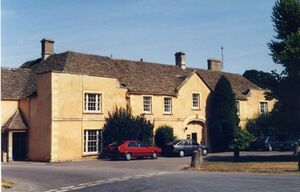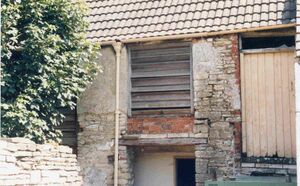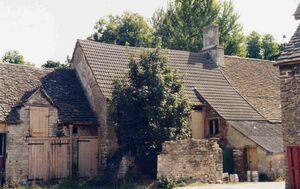Joseph Davies
Joseph Davies, Portcullis Brewery, Great Badminton, Gloucestershire.
Recorded in 1902.
The brewery for Badminton House and the Beaufort Estate.
Still extant with tap house now social club for estate workers.
PORTCULLIS INN AND BREWERY, BADMINTON, GLOUCESTERSHIRE by Ian Peaty
The approach to Badminton House, the seat of the Duke and Duchess of Beaufort, is through the delightful village of estate houses, built of the lovely warm yellow Cotswold stone. Each of these houses is resplendent with the "Portcullis" crest of the Ducal family, as is the long building facing the small greensward near the entrance to the park; this was formerly the Portcullis public house.
The symmetrical building has a central archway with a pediment, and on either end a raised parapet. The windows and doors are framed in stone and each dormer has a castellated stone quoin. The roof is of local stone as are most of the village houses, although there are several Cottages Ornes, with overhanging thatched roofs supported by rustic wooden posts. A map held at Badminton House muniment room dated 1708 indicated a large building on the same site, although there is no reference as to its use. The first record of the Portcullis Inn is an inventory dated 1780, although the first Duchess of Beaufort was responsible for the village Almshouses and school built in 1714. The archway with its Portcullis keystone, led into a double courtyard, with a brewery adjacent at right angles to the rear of the alehouse. This range of stone built buildings continued at various heights serving several purposes connected with horses. Forming a line parallel to the alehouse are a large number of stables, with a smaller tack house protruding into the yard.
The two storey brewhouse has two wooden louvered windows to the top floor, with access to this level previously via an external stone staircase. Overlooking the stairs is a stone mullioned window above the lean-to single storyed cellar. Besides the ground floor entrance door there is a stone wall enclosure, the site of the original water supply to the brewhouse, replaced in 1898 by the West Gloucestershire Water Company.
Joseph Davies was the last brewer, when in 1902, an inventory was made prior to the plant being disposed of. This shows that there was a vertical 4 HP steam engine with feed pump and all the necessary iron shafting, belts, cogs etc. to drive all the plant. There were two coppers, one of 60 gallon capacity with two brass cocks, the other 300 gallon capacity, both with timber staging. There was a galvanised portable hop back, two coolers measuring 13 feet by 6 feet; a vertical refrigerator built by Llewellyn and James; mash tun with iron false bottom copper slotted, and a mashing machine fixed to the grist case. The underback was made of oak and held 220 gallons, and the movement of the wort was assisted by several gun-metal pumps. There were seven vats in the cellar ranging in size from 1,800 gallons to 2,560; with a total capacity of 14,660 gallons. On the day the inventory was carried out there was 4,656 gallons of "Old Beer" and 4,085 of "Mild" in these vats. "On Tap" in the cellar were three hogsheads and 80 dozen of small Bass bottles and 6 dozen and 8 small bottles of Coomb Valley Brewery Stout.
In this inventory there is no listing of any malt, although one pocket each of Farnham and Worcester hops are mentioned in addition to two Bavarians. It would therefore seem apparent that brewing had just ceased prior to the inventory being carried out. In the office there was a "4 Motion Bottling Machine", scales and weights, a Brewers Saccharometer in case, a new copper Thermometer and two wood Rousers. It is evident from these brewing plant details that the Portcullis Inn was a busy establishment, primarily serving Badminton Estate workers. During the period 1899-1903, quite large quantities of beer were supplied to Badminton House. These purchases were for harvesters, haymaking, carpet beating and special occasions such as the visit of the Prince and Princess of Wales from 3rd to 5th March, 1902. In 1903 the following meals were supplied to Estate Workers:- 1st July, - 46 rent audit dinners; 8th July - 132 earth stoppers feast dinners; 1st August - 150 Puppy Show luncheons. At these occasions beer was of course supplied, and this came from the Portcullis brewery, as the brewhouse at Badminton House had closed many years previously.
An establishment of estate workers was made in 1836 for his Grace the 8th Duke of Beaufort totalling 271 persons. Of these, sixty-seven were in the house, and besides, a Steward, Butler, Grooms, Ushers, Footmen, Lady's Maid, Housemaids, Charwomen, Nurses, Brewers, Bakers, two Odd Men for sundry work, Butcher, Knife Boy and many others. In the stables there were 119 horses for carriages, huntings, hacks, ponies etc. with 39 staff to look after them. The extensive gardens had 29 staff and a further 14 looking after the game, particularly the four hundred Red Deer and 1,400 Fallow Deer. Twenty-eight tradesmen maintained the house and its many out-buildings, including a timber saw mill. Timber was and still is an important source of revenue, and in 1836 there were eighteen woodmen and cutters. To maintain the considerable roads, fences and walls, twenty boys were superintended by one man who also had a further twenty men to carry out stone quarrying.
The seventh Duke of Beaufort marked his eldest son's coming of age, reported in the London Gazette of 8th February, 1845, "The carcasses of no less than six oxen were given away, besides an immense quantity of other viands, and twenty hogsheads of strong ale", (this is 1,080 gallons or 8,640 pints). Next day 200 tenants (all men) sat down to dinner in the Servant's Hall to celebrate Henry Somerset's birthday. For such occasions, the brewhouse at Badminton House most likely called upon the neighbouring Portcullis Inn for additional supplies of beer, both "Mild" and "Old Ale".
In the late 19th century, the Beaufort estate included lands in the counties of Gloucestershire, Wiltshire, Brecon, Glamorganshire and Monmouthshire, totalling some 51,000 acres. During this century large tracts of the former considerable estate have been disposed of, including Raglan Castle, Tintern Abbey and Troy House. Consequently the large number of estate employees has dwindled with these cutbacks and that of the once lavish hospitality and renowned charitable activities; Badminton House is of course so well known today for its Whitbread Brewery sponsored three-day eventing horse trials, which continue the legendary horse interests of the Dukes and their Beaufort Hunt.
Sources: “Badminton ouse, A Guide” c.1983. Author’s Note: I am indebted to Mrs Marggaret Richards, Archivist to his Grace the Duke of Beaufort, KG, GCVO, and her Grace the Duchess of Beafort.



